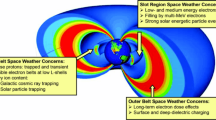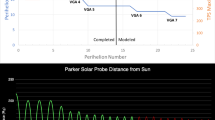Abstract
In the last 40 years, the increased space activity created a new form of space environment of hypervelocity objects—space debris—that have no functional use. The space debris, together with naturally occurring ultrahigh velocity meteoroids, presents a significant hazard to spacecraft. Collision with space debris or meteoroids might result in disfunction of external units such as solar cells, affecting materials properties, contaminating optical devices, or destroying satellites. The collision normally results in the formation of additional debris, increasing the hazard for future missions. The hypervelocity debris effect is studied by retrieving materials from space or by using ground simulation facilities. Simulation facilities, which include the light gas gun and Laser Driven Flyer methods, are used for studying the materials degradation due to debris impact. The impact effect could be accelerated when occurring simultaneously with other space environment components, such as atomic oxygen, ultraviolet, or x-ray radiation. Understanding the degradation mechanism might help in developing materials that will withstand the increasing hazard from the space debris, allowing for longer space missions. The large increase in space debris population and the associated risk to space activity requires significant measures to mitigate this hazard. Most current efforts are being devoted to prevention of collisions by keeping track of the larger debris and avoiding formation of new debris.
Similar content being viewed by others
References
E.M. Silverman, “Space Environmental Effects on Spacecraft—LEO Material Selection Guide” (NASA Contractor Report No. 4661, Langley Research Center, 1995).
A.C. Tribble, The Space Environment: Implementation for Spacecraft Design (Princeton University Press, New Jersey, 1995).
J. Miao, J.P.W. Stark, Planet. Space Sci. 49, 927 (2001).
J.C. Mandeville, L. Berthoud, Adv. Space Res. 16, 67 (1995).
K.G. Paul, E.B. Igenbergs, L. Berthoud, Int. J. Impact Eng. 20, 627 (1997).
S.G. Love, D.E. Brownlee, N.L. King, F. Horz, Int. J. Impact Eng. 16, 405 (1995).
J.C. Mandeville, Adv. Space Res. 13, 123 (1993).
NASA Langley Research Center, Impact Damage of LDEF Surfaces (http://setas-www.larc.nasa.gov/LDEF/MET_DEB/md_im pact.html), 2001.
Orbital Debris Quarterly News 13, 1 (April 2009).
E.L. Christiansen, J.L. Hyde, R.P. Bernhard, Advances in Space Research 34, 1097 (2004).
D.J. Kessler, R.C. Reynolds, P.D. Anz-Meador, NASA TM-100471 (1988).
C.A. Belk, J.H. Robinson, M.B. Alexander, W.J. Cooke, S.D. Pavelitz, NASA RP-1408 (1997).
H. Klinkrad, Proc. Inst. Mech. Eng. Part G J. Aerosp. Eng. 221, 955 (2007).
A.M. Bradley, L.M. Wein, Adv. Space Res. 43, 1372 (2009).
J. Hyde, E. Christiansen, D. Lear, J. Kerr, F. Lyons, J. Yasensky, Orbital Debris Quarterly News 11 (2007).
V. Jantou, D.S. McPhail, R.J. Chater, A. Kearsley, Appl. Surf. Sci. 252, 7120 (2006).
B.K. Wells, Int. J. Impact Eng. 33, 855 (2006).
H.L.K. Manning, J.M. Gregoire, Int. J. Impact Eng. 33, 402 (2006).
R. Verker, N. Eliaz, I. Gouzman, S. Eliezer, M. Fraenkel, S. Maman, F. Beckmann, K. Pranzas, E. Grossman, Acta Mater. 52, 5539 (2004).
C. Stein, R. Roybal, P. Tlomak, W. Wilson, Space Debris 2, 331 (2000).
M. Grujicic, B. Pandurangan, C.L. Zhao, S.B. Biggers, D.R. Morgan, Appl. Surf. Sci. 252, 5035 (2006).
T. Kadono, Planet. Space Sci. 47, 305 (1999).
J.H. Robinson, A.M. Nolen, Int. J. Impact Eng. 17, 685 (1995).
R. Roybal, P. Tlomak, C. Stein, H. Stokes, Int. J. Impact Eng. 23, 811 (1999).
N. Kawai, Y. Harada, M. Yokoo, T. Atou, K.G. Nakamura, K. Kondo, Int. J. Impact Eng. 35, 1612 (2008).
G. Caprino, V. Lopresto, D. Santoro, Composites Science and Technology 67, 325 (2007).
M. Lambert, F.K. Schäfer, T. Geyer, Int. J. Impact Eng. 26, 369 (2001).
W.L. Cheng, S. Langlie, S. Itoh, Int. J. Impact Eng. 29, 167 (2003).
R.C. Tennyson, G. Shortliffe, 7th Int. Symp. Mater. Space Environ. 399, 485 (1997).
C. Stein, R. Roybal, P. Tlomak, in 8th Int. Symp. Mater. Space Environ., E. Werling, Ed. (CNES Publication, Arcachon, France, 2000).
J.A. Akins, PhD degree thesis, California Institute of Technology (2003).
R. Verker, E. Grossman, I. Gouzman, N. Eliaz, High Perform. Polym. 20, 475 (2008).
R. Verker, E. Grossman, I. Gouzman, N. Eliaz, Polymer 48, 19 (2007).
M.H. Klopffer, B. Flaconneche, Oil & Gas Science And Technology-Revue De L Institut Francais Du Petrole 56, 223 (2001).
A.F. Whitaker, B.Z. Jang, J. Appl. Polym. Sci. 48, 1341 (1993).
R. Klein, M.D. Scheer, J. Phys. Chem. 72, 616 (1968).
E. Grossman, I. Gouzman, G. Lempert, Y. Noter, Y. Lifshitz, J. Spacecr. Rockets 41, 356 (2004).
J.C. Liou, N.L. Johnson, Science 311, 340 (2006).
A. Rossi, G.B. Valsecchi, Celestial Mech. Dyn. Astron. 95, 345 (2006).
F. Alby, B. Deguine, C. Bonnal, P.M. Ratte, in 55th International-Astronautical-Federation Congress (IAF) (Vancouver, Canada, 2006), pp. 3–10.
Technical Report on Space Debris (United Nations Publication, New York, 1999).
NASA Safety Standard, NSS 1740.14 (1995).
V. Adimurthy, A.S. Ganeshan, Acta Astronaut. 58, 168 (2005).
V. Chobotov, N. Melamed, W.H. Ailor, W.S. Campbell, Acta Astronaut. 64, 946 (2009).
J.C. Liou, N.L. Johnson, Acta Astronaut. 64, 236 (2009).
D. Rex, Acta Astronaut. 41, 311 (1997).
D. Rex, Space Policy 14, 95 (1998).
Rights and permissions
About this article
Cite this article
Grossman, E., Gouzman, I. & Verker, R. Debris/Micrometeoroid Impacts and Synergistic Effects on Spacecraft Materials. MRS Bulletin 35, 41–47 (2010). https://doi.org/10.1557/mrs2010.615
Published:
Issue Date:
DOI: https://doi.org/10.1557/mrs2010.615




